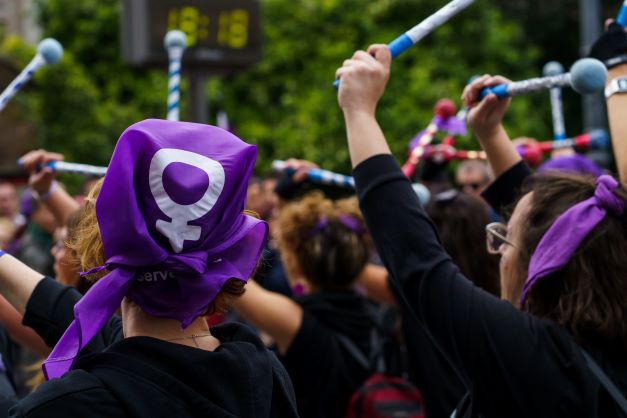As online violence against women and girls continues to escalate, our responses must rapidly evolve as well. We look at online and offline strategies to make digital spaces safer for all.
In our era of rapid technological advancement, online gender-based violence and harassment against women and girls is gaining much-needed attention. Technology-Facilitated Gender-Based Violence (TFGBV) can manifest in various forms, including cyberstalking, harassment, non-consensual sharing of intimate images, and direct threats. The internet’s global reach means that individuals can be targeted across borders and cultures.
While anyone can be subjected to TFGBV, women, girls, and gender nonconforming individuals are often disproportionately affected. According to the Economist Intelligence Unit, approximately 85% of women around the world have either witnessed or experienced online violence. Yet despite this staggeringly high statistic, TFGBV is most likely underreported, as only one in four women report harmful behavior to the online platforms where incidents occur. Many victims may not report incidents due to fear, stigma, or a lack of awareness about available reporting mechanisms.

Educating individuals about online safety, consent, and the repercussions of engaging in harmful behavior is crucial.
Online gender-based violence can have serious consequences for the mental health and wellbeing of those affected, and the constant threat of harassment, coupled with the potential for public shaming, can create a hostile online environment. As the U.S. Strategy and National Action Plan on Women, Peace and Security notes, TFGBV “disincentivizes women from engaging in political discussions both online and offline, which, in turn, impacts the stability of democracy.” In addition, a UN report found that “30% of women journalists in a global survey responded to online violence by self-censoring their journalism on social media, while 20% reported withdrawing from all online interaction.”
In response, Dexis recommends a two-pronged approach to address TFGBV—harnessing the power of AI paired with good, old-fashioned human effort.
Tech Fights Back
When harnessed correctly, AI has the powerful potential to prevent, respond to, and even document TFGBV. As noted, TFGBV is challenging to measure accurately given underreporting but also due to varying definitions of online violence and the rapidly changing nature of technology.
As one report states, “AI can analyze vast datasets to identify patterns, risk factors, and trends associated with violence against women, aiding in evidence-based policy development and intervention strategies.” Similarly, using machine learning, AI can analyze behavior, social media messages, and emergency phone calls as a form of early detection and can be instrumental in employing early interventions.
AI can also play a pivotal role in gathering data to enhance our comprehension of the drivers of violence and the profiles of perpetrators. Dexis’ social listening or “SOLIS” tool, which piloted a study on social media discussions related to irregular migration, serves as a valuable example of how AI-powered social listening can provide insights into online narratives and sentiments. SOLIS allowed Dexis to identify key messages and media that influenced Hondurans’ perceptions about migration to the U.S.
When developing technology products to combat TFGBV ensure that they’re sensitive to the needs and experiences of survivors. For example, this includes having survivors test or scale relevant technology products and approaches.
The Human Factor
While AI is a potent tool, comprehensively addressing TFGBV entails survivor-sensitive policies, laws, and awareness campaigns. The collaboration of various stakeholders, including government bodies, tech companies, and advocacy groups, is essential in creating a holistic and effective response.
Legal Frameworks: Governments should enact and enforce laws and policies that specifically target online violence. Laws that hold perpetrators accountable for their actions with citizens and civil society organizations monitoring their governments’ progress towards stated commitments can address TFGBV. Mexico’s “Olimpia Law”, which criminalizes digital violence against women, is inspiring a push for similar responses in other Latin American countries.
Education and Awareness: Educating individuals about online safety, consent, and the repercussions of engaging in harmful behavior is crucial. This includes amplifying the voices of women and girls in digital spaces, supporting them when they choose to speak out against online harassment
Social Media Platforms: Tech companies should continue to develop and enforce policies that prohibit harassment and violence online. Reporting mechanisms and support for victims should be readily available. Training individuals how to use these mechanisms, as Dexis did with college-age youth around hate speech in Ethiopia, helps reduce the spread of abusive online behavior.
Support Networks: Communities, both online and offline, can provide crucial support and resources to victims. Local leaders and organizations must also employ survivor-centered approaches (e.g., prioritizing the rights, needs, and wishes of the survivor) to be effective. Also key is creating safe spaces where women and girls can receive guidance and ongoing support.
Collaboration: Collaborative efforts can yield more effective solutions than isolated responses. This can include organizations, researchers, and policymakers working together to conduct studies and gather data on online harassment and using findings to develop, test, and refine strategies and policies. The Global Partnership for Action on Gender-Based Online Harassment and Abuse, for example, brings together the United States with Australia, Denmark, the Republic of Korea, Sweden, and the United Kingdom to fight TFGBV.
As highlighted in USAID’s Digital Strategy, “digital ecosystems are stronger and more sustainable when they work for everyone.” As we navigate the complex landscape of online violence and harassment against women and girls, harnessing the power of AI is a crucial step forward. By combining AI with traditional tools of civic education and alliances, we can combat online gender-based violence and work towards creating a safer digital space for all.
Special thanks to Dexis’ Center for Global Security and Stabilization for their contributions to this blog.





